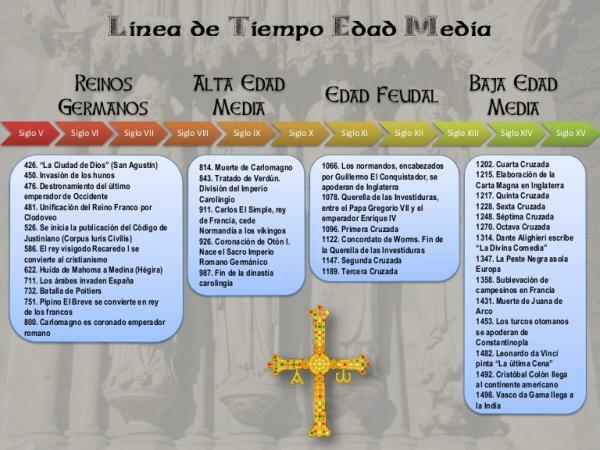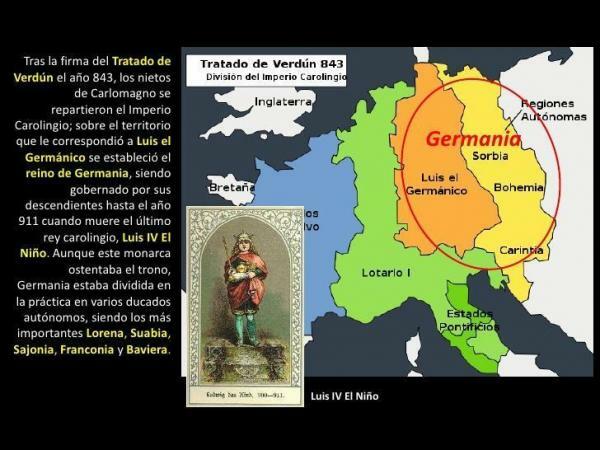Important events of the Middle Ages

Image: Slideshare
The Middle Ages spans from the 5th to the 16th century. During that great number of years, we will find a series of events that ended in the conformation of the Modern State. In this lesson from a TEACHER we bring you the most important events of the Middle Ages, which we will summarize in chronological order: from the disappearance of the Western Roman Empire to the discovery of America.
Index
- The Western Roman Empire
- The Islamic invasion
- The Carolingian Renaissance
- The Holy Roman Empire
- Time of famine
- The Hundred Years War
- The black plague
- The schism
- The Reconquest and the discovery of America
The Western Roman Empire.
In the year 476 the last emperor of Rome, Romulus Augustus, was deposed, by the head of the Heruli, Odoacer, on September 4. That date is the beginning of the Middle Ages, although there are many authors who affirm that it had begun some time ago, although it is true that changes had been taking place for a century before.
But what we have to be clear about is that, when the emperor of Rome was dethroned, Italy became a barbarian kingdom and its king did not at any time raise the intention to maintain the Empire, which on the other hand would have been unfeasible since since the third century the different provinces of the Empire had gone installing barbarian peoples who were creating their own kingdoms independent.
In this other lesson we will discover the causes of the fall of the Roman Empire.

Image: Hellenos and Latinos
The Islamic invasion.
Without a doubt, among the most important events of the Middle Ages we highlight the birth of Islam in the 5th century that it would be a big problem for Europe and the Middle East.
In this way Byzantium or the Eastern Roman Empire began to suffer from the year 637 the constant attack of the forces of Islam in their quest to conquer the lands of the infidels. Between the year 637 and the year 1453, Byzantium was losing ground to the ArabsAlthough it had some moments of military rebound, although it is true that, although they lost ground, their culture prevailed.
Regarding Europe, we must know that, from North Africa, in 711 there was the invasion of the Iberian Peninsula, ending one of the most important kingdoms, the Spanish Visigothic kingdom. The Muslims would even reach the south of France, where they were repelled by Carlos Martel, in the battle of Tours in 732, expelling the Muslims back to the peninsula.
In this other lesson we discover a summary of the Muslim invasion in the Iberian Peninsula.

The Carolingian Renaissance.
Carlos Martel ended the Merovingian dynasty and was the one who laid the pillars for the creation of the feudal system. One of the most important events of the Middle Ages was undoubtedly the coronation of Charlemagne as emperor of the Romans in 800, being the first barbarian monarch to be crowned by a pope, after the deposition of Romulus Augustus.
Added to this was the annexation of France, Germany, the Netherlands, Catalonia, Germany and Italy, under the command of said monarch, who was able to re-form a empire in europe. It was also a period in which culture began to flow little by little again, along with art, all thanks to the help of the Church, which, since the fall of the Empire, had kept in its libraries all the knowledge of past times so that they would not be lost.

The Holy Roman Empire.
Although Charlemagne had formed an empire, after his death he decided to distribute it among his children, thus beginning a time of deterioration in which the different kingdoms began to battle each other, in addition to beginning a disintegration into principalities or fiefdoms, due to the power held by the nobility.
One of the territories belonging to the Carolingian Empire, Germany, would be in the year 962 the one that maintained the privilege of having the emperor of the Romans. So lthe kings of Germany, were appointed as emperors by the pope as northern Italy was under German jurisdiction. This would continue until the First World War although with a series of changes over the centuries.
In this other lesson we discover a summary of the Holy Roman Empire.

Image: Slideshare
Time of famine.
Between 1315 and 1317 in northern Europe there was a period of great famine due to a series of climatic changes, which favored that the field did not bear fruit, causing the population was weakened excessively and thus giving way to a series of diseases that ended up reducing the population population.
To this must be added the birth of a series of tensions against the lords, who kept large numbers in their granaries. It will therefore be time to uprisings of the people against their lords.
The Hundred Years War.
Between 1337 and 1453 there was one of the most intense warlike phenomena in Western Europe between the kingdom of England and France to get the French throne: the Hundred Years War.
It was a very long period where we will find a large number of parentheses, in which the different kingdoms were recovering to continue the fight. In this other lesson from a TEACHER we will discover the causes and consequences of the 100 years war.

Image: Universal History
The black plague.
Without a doubt, one of the most important events of the Middle Ages was the so-called black death, an epidemic that between the years 1348 and 1350 wreaked great havoc throughout Europe.
This epidemic came from the hand of rats that carried the plague from Asia to Italy, due to the incipient trade that was re-emerging at the hands of the Venetians, it soon spread throughout the West and central Europe. This caused the workforce to decline and thanks to that, the peasants and artisans were able to demand better treatment from their lords and the Church.
The schism.
Between the years 1378 and 1417 we will find one of the most important events of the Middle Ages. Although from the middle of the eleventh century the Church had divided in the West and the East, a series of conclaves were still being held to lead it.
At that time, the situation of the Roman Church was unsustainable, due to the great corruption that was within itself and this led to the appearance of three candidates for the papacy which led to an internal and legal struggle that ended up dividing the Church in two: the Roman and the Orthodox.
In this other lesson we offer you a summary of the church in the Middle Ages.
The Reconquest and the discovery of America.
To conclude our lesson, we must know that between the year 711-1492, the phenomenon known as the reconquest, by which the kingdoms of Castile, Aragon, Portugal and Navarra were formed, these being those who were gradually breaking down the Muslims who had invaded the Spanish Visigothic kingdom.
During this, classical Greek texts were introduced to the Peninsula, which were translated into Spanish, thus increasing the culture of the European kingdoms. This period ends with the conquest of Granada in 1492, likewise, we must know that in that year would discover americaat the hands of Christopher Columbus.

If you want to read more articles similar to Important events of the Middle Ages, we recommend that you enter our category of Story.



